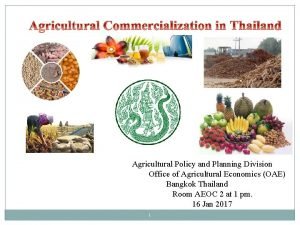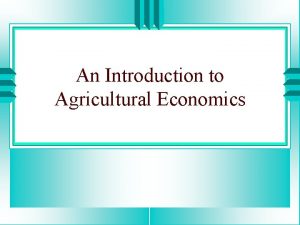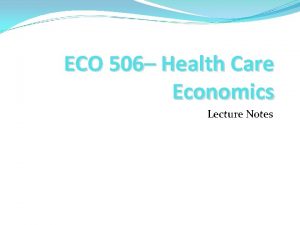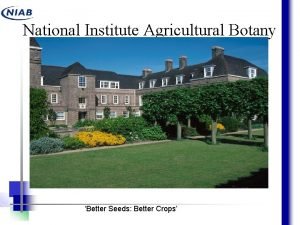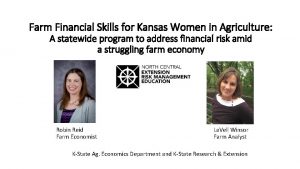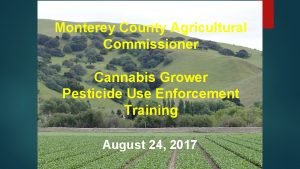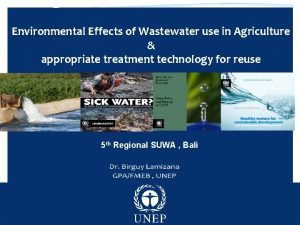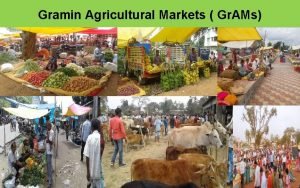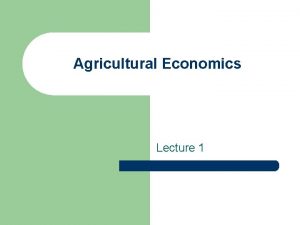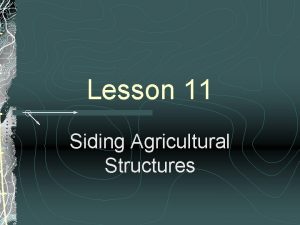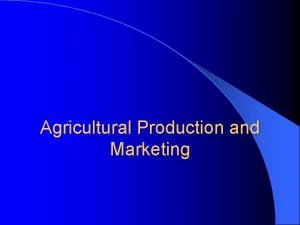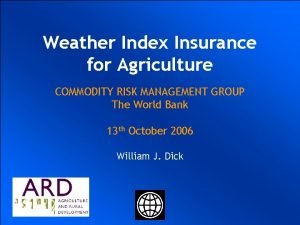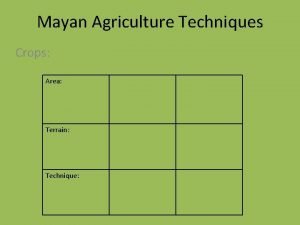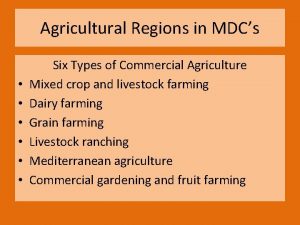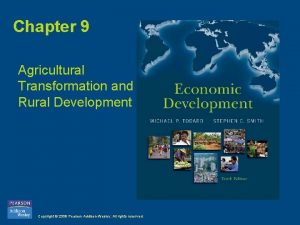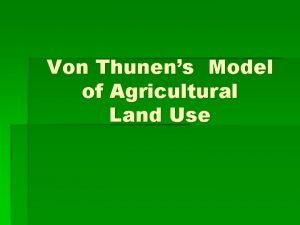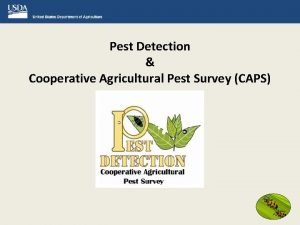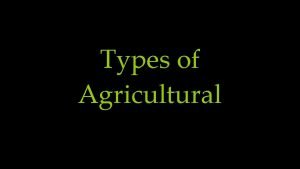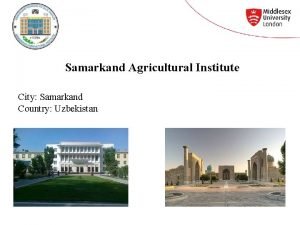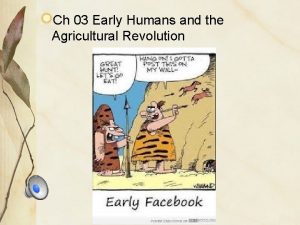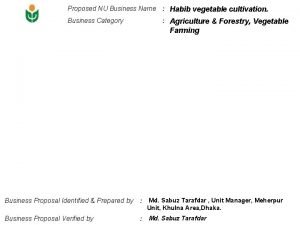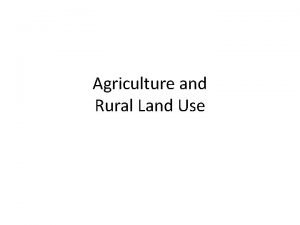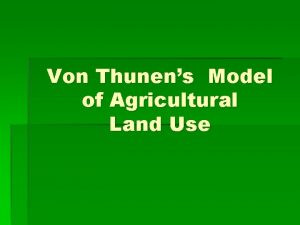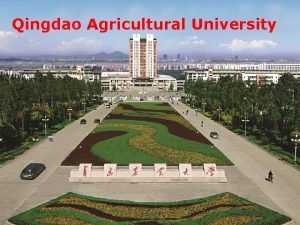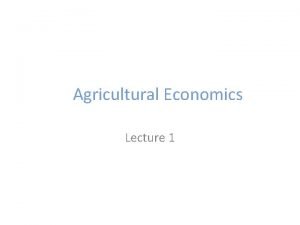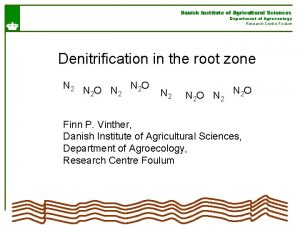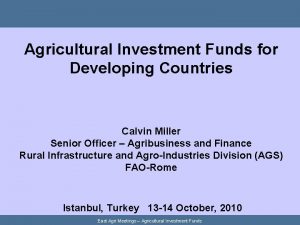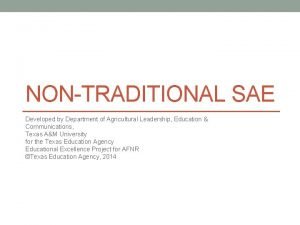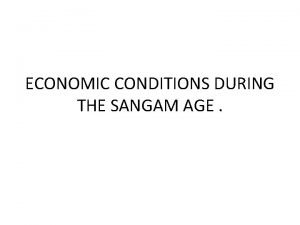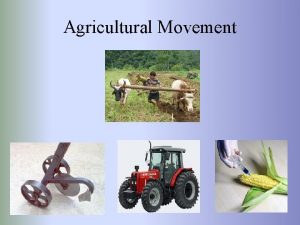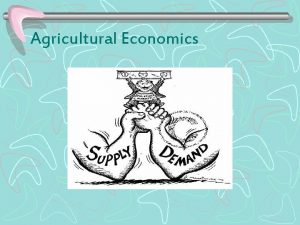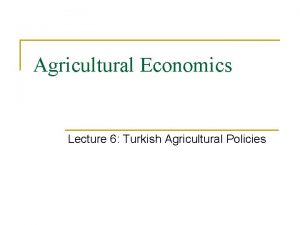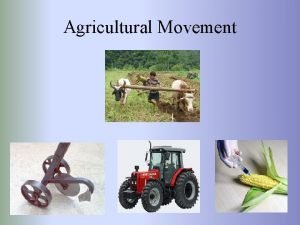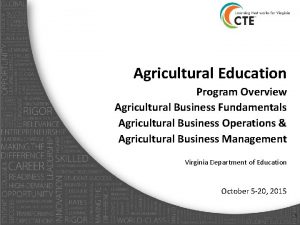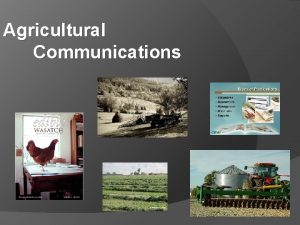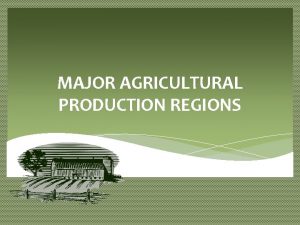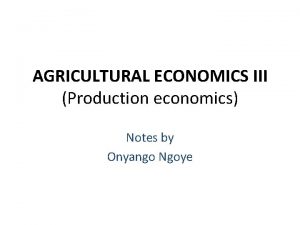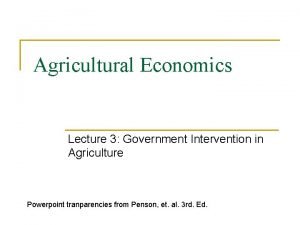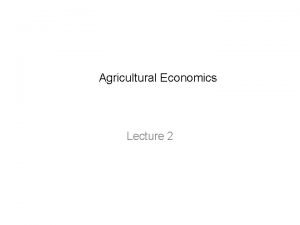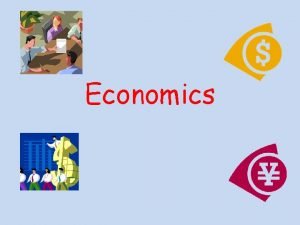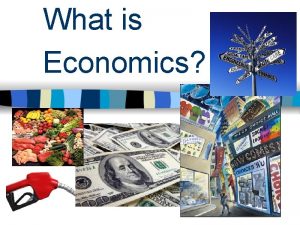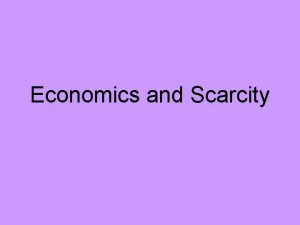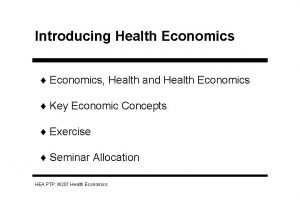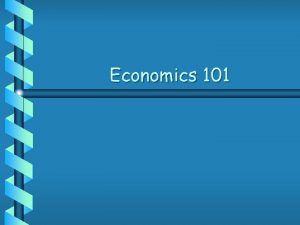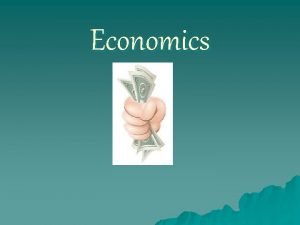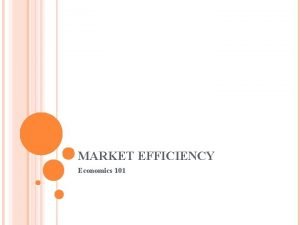Agricultural Economics Lecture 1 What is Agricultural Economics



















































- Slides: 51

Agricultural Economics Lecture 1

What is Agricultural Economics? • “…an applied social science that deals with how producers, consumers and societies use scarce resources in the production, processing, marketing and consumption of food and fiber products”.

What is Agricultural Development? • Here development means what happens over time • change, evolution, growth • it may be an improvement… or not. • We focus on what happens to the whole country • to the entire agricultural sector, • given overall economic development: – higher income, production and consumption – improved health and life expectancy – and many other changes…

• A key change over time is that people get richer, so when we talk of “more” or “less” developed, what we usually mean is “richer” or “poorer”. • We will usually be descriptive, asking: –what happens over time, • as countries get richer? –what differs across countries • between rich & poor? • And sometimes we will be prescriptive, asking – what should be done, • to help people get what they want?

• Development involves accumulation, that economists call “capital”: – physical capital (houses, roads, machines) – human capital (education, health) – institutional capital (“rules of the game”) • The accumulation of capital makes it more abundant and cheaper. • But accumulation doesn’t happen automatically. • To build up capital, people must save and invest from one year to the next.

• Development also involves innovation, which economists call “technical change”: – new physical things (seeds, chemicals, etc. ) – new ideas (crop rotations, etc. ) – new institutions (futures markets, etc. ) • Innovation makes it possible to produce more of what people want, from the resources they have. • But innovation doesn’t happen automatically. • To innovate, people must be able to change what they do.

Agriculture as a share of GDP vs. GNP per capita, 1989 Source: GW Norton and J Alwang, Introduction to Economics of Agricultural Development. New York: Mc. Graw Hill, 1993.

Agriculture as a share of employment vs. GNP per capita, 1985 Source: GW Norton and J Alwang, Introduction to Economics of Agricultural Development. New York: Mc. Graw Hill, 1993.

Percent of income spent on food vs. GNP per capita, 1980 s Source: GW Norton and J Alwang, Introduction to Economics of Agricultural Development. New York: Mc. Graw Hill, 1993.




YEARS SHARE OF AGRICULTURE (%) SHARE OF INDUSTRY (%) SHARE OF SERVICES (%) 1980 24, 2 20, 5 55, 4 1981 22, 6 21, 5 55, 9 1982 22, 7 21, 9 55, 4 1983 21, 6 22, 4 56 1984 20, 3 23, 1 56, 6 1985 19, 4 23, 6 57 1986 18, 8 25 56, 2 1987 17, 2 24, 9 57, 9 1988 18, 3 25, 1 56, 7 1989 16, 6 25, 9 57, 5 1990 16, 3 25, 9 57, 9 1991 16, 1 26, 5 57, 4 1992 15, 8 26, 5 57, 8 1993 14, 5 26, 5 59 1994 15, 3 26, 6 58, 1 1995 14, 4 27, 7 57, 9 1996 14 27, 7 58, 3 1997 12, 7 28, 1 59, 2 1998 13, 4 27, 6 59 1999 13, 4 27, 9 58, 7 2000 13, 1 27, 8 59 2001 13, 7 28, 5 57, 8 2002 13, 7 29, 3 56, 9 2003 12, 6 29, 9 57, 5






The Functions of Agriculture Function 1: Provide food for humankind Malthus’ theory of the capacity of world to feed humankind: Geometric increase in human population vs. arithmetic increase in food poduction.

• Function 2: Provide raw material for the industry • Function 3: Provide opportunity for rural lanscape • Function 4: Source for capital accumulation for development • Function 5: Source of labor for the industry

Why Does Agriculture’s Share Declines in Economic Development? • Inelastic income elasticity of demand for staple foods: as per capita income rises, declining proportion of household expenditure is devoted to food. • By Engel's law, as per-capita income rises, the proportion of income spent on food declines relative to other products.

• As household demand for food declines in relation to other products, relative prices of foods decline, other things equal. • This in turn reduces returns to factors used in agricultural production, causing a net migration of labor and capital to other sectors. • Share of agriculturen declines over the economic development process. .

• Almost always, agriculture declines – In employment share – In share of GDP or GNP (national income) – In share of consumer expenditure • Do farmers get poorer? • Are there fewer farmers?

Agricultural Policy • Policy is guiding principle leading to a course of action that is pursued by the government. • Policies and programs • Major forces for policy change: – – – – Instability Globalization Technology Food safety Environmeny Industrialization of agriculture Politics Unforseen events

What is Agricultural Policy? • A subset of public policy directed primarily but not exclusively at the farm and agribusiness sectors of society.

Agricultural policy applies to two markets: • • • 1. AGRICULTURAL INPUT MARKETS USE OF LAND OTHER NATURAL RESOURCES AGRICULTURAL CREDIT AND FINANCE LABOR INDUSTRIAL PRODUCTS 2. AGRICULTURAL OUTPUT MARKETS PRODUCTION CONSUMPTION MARKETING INTERNATIONAL TRADE

• Food is one of the great universals in our lives and one of the things that brings us together. – The industrial complex that produces, processes, and distributes it is one of the largest industries in the world. • On a global basis the food industry is the largest industry in terms of people employed and value of product. The following slides are from E. Drummond and J. W. Goodman. Agricultural Economics, Pearson, 2011

• The food industry can be divided into four major sectors: – Farm service, producers, processors, and marketers. • For every $100 spent at the supermarket… – The farm service sector accounts for about $12. – The production sector (i. e. , farmers), about $7. – The remaining $81 goes to processors of agricultural commodities, and the marketing system that brings food to your table.

Farm Service Sector • The farm service sector provides producers with the inputs such as feed, fertilizer, fuel, equipment, and chemicals. – Many firms are multinational corporations with household names such as John Deere, Du. Pont, and Monsanto. 2 3 There is also a variety of small, local service companies that serve diverse needs of local farmers for irrigation equipment, farm structures, etc. 4

Farm Service Sector • There also numerous firms that provide farmers with services such as banking, accounting, insurance, legal advice, and agronomic consulting. • As farming becomes increasingly complex, farmers are pressed to rely heavily on providers of farm services—a fast-growing, highly localized sector of the food industry.

• Producers The producers sector includes all of those firms engaged in the biological processes associated with production of food & fiber. – Examples include farmers, ranchers, grove & nursery owners. 3 Producers buy from the farm service sector and sell to the processor sector. 4

Producers • Unique about producers is the link, often nostalgic, to the biological processes of producing raw food products—Mother Nature. – While the link is appealing, most producers are rapidly becoming little more than food factories.

• Processors The processors sector creates value converting agricultural commodities into those products that consumers want. – Processors change the form of food and create value in the process. 4

Processors • Processors can be divided into two groups: – Commodities processors - (milling wheat into flour). – Food products processors - (bakers who turn flour into bread). • Frequently, a company engages in both activities: – Hershey processes cocoa beans & makes chocolate bars. – Con. Agra Foods processes soybeans into oil, to make Blue Bonnet®, Fleischmann’s®, and Parkay® margarines. • Con. Agra Foods also sells soybean oil directly.

Processors • Food product processors can be further divided into:

Processors • Food product processors can be further divided into: – Those that produce for the retail food consumer.

Processors • Food product processors can be further divided into: – Those that produce for the retail food consumer. – Those that produce for food service distributors. Today roughly one-half of all spending on food is for food eaten away from home This is the market food product processors serve.

• Processors A good example of a food product processor is the Coca-Cola Company. – It buys high-fructose corn sweetener from a commodity processor such as ADM or Cargill.

• Processors It combines the HFCS with other ingredients, using their secret formula, to produce Coke®. – In cans and bottles for the retail market. – In bulk for the food service industry.

Processors • Following the diagram, we can understand that Coca-Cola also plays the role of wholesaler and distributor in the marketing sector. Coca-Cola spans both the last half of the processing sector and the first half of the marketing sector.

Marketers • The marketers sector also creates value in the food industry by changing the time and place of food. – The distribution system that ties producer and consumer together is the marketing system. It brings the consumer what he/she wants, where & when it is wanted.

• Marketers The food marketing system is so effective and efficient that most of us take it for granted. – Only when the system is disrupted by a hurricane or a massive snow storm do we recognize how flawlessly and easily the food distribution system usually operates.

FOOD INDUSTRY CONTEMPORARY ISSUES • Like any other major industry, the food industry is in a continuous dynamic of change and adjustment.

• Globalization In most instances, commodity processors tend to be on the forefront of globalization. – Because demand for processing technologies is truly global—we all need food to survive. • Among commodity processors, the most successful are very internationalized, with processing facilities all over the globe. – To fail to behave globally in the commodity processing business is a recipe for corporate failure.

Globalization • Globalization in food products processing has not been as strong, as consumers in each country have different tastes and preferences. – The final food product soybeans may be soy protein meal in one country, tofu in another, and a nice steak in a third. • Many food product processors are making a push to globalize, seeing growth of the processed food market exploding in many developing countries. – Growth of the market in the U. S. is basically stagnant. • There are three truly global food product processing companies: – Coca-Cola, Unilever, and Nestlé.

• Globalization Nestlé is the largest processor of food products in the world. – Their strong suit is the infant formula market. • Most may associate Nestlé with chocolate bars and hot cocoa mix. – Nestlé also appears as Nescafé®, Taster’s Choice®, Perrier®, Friskies®, Alpo®, Mighty Dog®, Baby Ruth®, Butterfinger®, Power. Bar®, and Carnation®.

• Globalization Criticisms Food security—every country wants to be certain its nutritional needs will be met. – As the industry becomes globalized, individual countries are losing control to multinational companies that may have objectives different from those individual countries. • Global concentration—similar to the issue of industrial concentration. – A Brazilian firm, the world’s largest beef processor has acquired of one of the largest U. S. beef processors. • Many individuals are concerned about the loss of national identity associated with globalization. – Skeptics see the future of a homogenized world in which French and Swiss cheeses all turn into cheddar.

• Coordination Marketers are the companies that tie the final food consumer to the processor. – Their job is to make certain that whatever the consumer wants is there when and where the consumer wants it. As shown, the traditional retail marketing system is quite distinct from the food service distribution system. The communication system that conveys consumer wants to the producer is called coordination.

Coordination • Traditionally, coordination has been accomplished by prices sending messages from one link in the marketing chain to the next. – This is changing, with management & strategic alliances replacing markets & the price system of allocation. • Most food purchased for home consumption is purchased at a retail supermarket. – Using technology, consumers can send signals to producers using hotlines, websites & product blogs.

Coordination • Traditionally, most retail stores purchased food from wholesalers, who purchased in bulk from processors, selling in smaller batches to retailers. – Many—particularly smaller—retailers still use this system. • Many larger chains combine wholesale and retail functions in a single firm, reducing transaction cost. – Reduced costs can be passed on to consumers as lower prices, or captured by the producer as higher profits.

Coordination - Vertical Integration • Vertical integration allows a firm to coordinate different stages in the food system through management. • With vertical integration as a dominant trend, we are seeing a rise in the role of management. – And a decline in the role of markets in the coordination of the food system.
 01:640:244 lecture notes - lecture 15: plat, idah, farad
01:640:244 lecture notes - lecture 15: plat, idah, farad Office of agricultural economics thailand
Office of agricultural economics thailand Agricultural economics
Agricultural economics Principles of economics powerpoint lecture slides
Principles of economics powerpoint lecture slides Land use planning '' lecture notes
Land use planning '' lecture notes Health economics lecture notes
Health economics lecture notes School of business and economics maastricht
School of business and economics maastricht What is mathematical economics
What is mathematical economics National institute of agricultural botany
National institute of agricultural botany Agricultural accounting and finance kansas
Agricultural accounting and finance kansas Monterey county cannabis program
Monterey county cannabis program Agricultural wastewater treatment technologies
Agricultural wastewater treatment technologies Gramin agricultural markets
Gramin agricultural markets What is agricultural development
What is agricultural development Siding channel types
Siding channel types Derwent whittlesey
Derwent whittlesey Characteristics of agricultural production
Characteristics of agricultural production Nrrl culture collection
Nrrl culture collection Agricultural weather index
Agricultural weather index Netsurf biofit agricultural products
Netsurf biofit agricultural products Mayan agriculture
Mayan agriculture Types of commercial farming
Types of commercial farming Agricultural revolution worksheet
Agricultural revolution worksheet Dvt agricultural bihar
Dvt agricultural bihar Chapter 9 agricultural transformation and rural development
Chapter 9 agricultural transformation and rural development Von thunen model usa
Von thunen model usa Cooperative agricultural pest survey
Cooperative agricultural pest survey Brotherhood ffa
Brotherhood ffa Intensive subsistence farming definition
Intensive subsistence farming definition Whittlesey classification
Whittlesey classification Samarkand agricultural institute
Samarkand agricultural institute Early humans and the agricultural revolution answer key
Early humans and the agricultural revolution answer key Swot analysis for agricultural business
Swot analysis for agricultural business Von thunen theory of agricultural location
Von thunen theory of agricultural location Bid rent theory
Bid rent theory Whittlesey agricultural regions
Whittlesey agricultural regions Agricultural produce accounting
Agricultural produce accounting Agricultural confined space training
Agricultural confined space training Jf agricultural engineering
Jf agricultural engineering Blue yonder lde
Blue yonder lde Von thunen 6 assumptions
Von thunen 6 assumptions Qingdao agricultural university
Qingdao agricultural university What is agricultural development
What is agricultural development Agricultural contractor job tracker
Agricultural contractor job tracker Danish institute of agricultural sciences
Danish institute of agricultural sciences Calvin miller coltivare
Calvin miller coltivare To practice brotherhood honor agricultural
To practice brotherhood honor agricultural Campus agricultural center
Campus agricultural center Supervised agricultural experience definition
Supervised agricultural experience definition Which was the most important industry in the sangam age
Which was the most important industry in the sangam age Agribusiness finance definition
Agribusiness finance definition Stages in agriculture
Stages in agriculture

